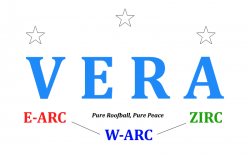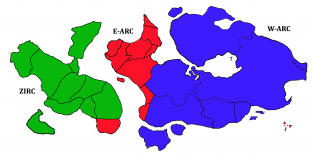Venturian Roofball Association
| Venturian Roofball Association (VERA) | |||||
|---|---|---|---|---|---|
| |||||
| General Information | |||||
| Abbreviation | VERA | ||||
| Motto | Pure Roofball, Pure Peace | ||||
| Type | International sports association Governing body of international Roofball | ||||
| Founded | February 3rd, 1955 Procantinac, Allia | ||||
| Headquarters | Altempel, Sacred Watch | ||||
| Member Nations | All Venturian Union Members (32) | ||||
| Official Languages | Allian English New Zwakazian Sacred Zwakazian Skethish | ||||
| Government | |||||
| President: | Quentin Myers United States of Quentin | ||||
| Senior Conference Manager: | Ramjek DeBlasio Xevenia | ||||
| Ranking Council Member: | Michelle Lankin Carkhia | ||||
| Governing Body | VERA Administrative Council | ||||
| Subsidiaries | E-ARC W-ARC ZIRC | ||||
| Affiliations | Sidus Dei Ludos Venturian Union | ||||
| Megasite | vera.org[1] | ||||
Contents
Competition Structure
The structure of competition in VERA has three stages, consisting of conference seeding matches, conference tournaments, and then the VERA World Cup. The first two stages are considered a part of the group play of the association, and thus each season is referred to by the year, and then VERA Group Play. In the conference seeding round, each conference has a different structure due to the composition of the conference. In the ZIRC, there are 10 member nations, and all conferences have even number members, making play easier. In the ZIRC, teams are randomly selected each year to play each other, by the president of the council. The president draws papers out of a hat to decide the first match, and there are 5 games in the first round of matches. Then, the teams are moved down the line so that each team plays all other teams, resulting in 9 rounds of play. Finally, at the end of the seeding round, the teams are ranked 1-10 based on their record. In E-ARC, there are 12 nations involved in the seeding round, and the same process of random selection takes place, although it is tradition for Bymaria and Carkhia to open the seeding round playing against each other. Finally, W-ARC has 10 teams, which operate on the same process of random selection.
The second step in VERA group play are the conference tournament rounds (known as the E-ARC Conference Championship, the W-ARC Conference Championship, and the Zwakazian Roofball Finals). After the seeding round, the 10 teams in ZIRC, 12 in E-ARC, and 10 in W-ARC are ranked in their respective conferences. The tournament begins with the top seed playing the lowest seed in each conference, second highest seed playing second lowest, and so on. Teams are eliminated by a system of double elimination, meaning after a loss, 5 teams in W-ARC and ZIRC and six in E-ARC are sent to the loser's bracket to play. Once the winner's bracket concludes with a winner, they play the winner of the loser's bracket. Whoever wins that match is ranked first. The second-place finisher and the runner-up in the winner's bracket then advance with the overall winner to the VERA World Cup.
The final step of the VERA play structure is the VERA World Cup. The world cup is considered independent of the group play for a season, much like the regular season in other leagues is separate from the playoffs. The World Cup today includes ten teams, three from each conference as described above, and the defending champions. If the defending champion is in the top three of one of the conferences, the next highest team will advance as well. The teams then play in a structure similar to the group stage, with the higher teams playing the lower teams, then advancing on until the finals round. The World Cup is single elimination. In the finals, the two remaining teams play, and the winner is crowned roofball champion of the world.
History
The Venturian Roofball Association was founded in 1955, after the Venturian Union Conference on Cooperative Recreation between all the members of the VU at the time. These nations decided at the conference in 1953 to expand international sporting competitions, like that of the Sidus Dei Ludos. Immediately, roofball, football, xevalhemia, and traditional athletics such as track and field were identified as the four sports to be immediately expanded upon. In late 1954, the representatives from all VU nations met in Procantinac to form the first international roofball association, writing the VERA Charter of Play as well as establishing the rules and competitions. Roofball was the first sport designated by the VU at the Recreation Conference to form an international league, and did so on February 3rd, 1955. Other organizations such as the IFX, WIFA, and the now defunct World Football Organization (WFO) formed later.
After the ratification of the charter of play by the 16 member states at the time, the VERA Administrative Council was put into action for the first time, with 33 representatives being present for its first session in July of 1955. The first president, Jose Minartez, is credited with naming the VERA World Cup, the first action of the new council. The council then established the three conferences of competition, and established the play of each state inside those conferences. Schedules were then made, and in 1957 the first season of VERA began. The season began as it does today, with seeding matches being played between teams in the same conferences. After these seeding matches, a tournament began inside the conferences, which was double elimination. Then, the top three teams from each conference moved on to the 1957 VERA World Cup, held in the summer of 1957. The nine teams competing were the United States of Quentin, Docneighland, Allia, Carkhia, Bymaria, New Sketherlands, the Nista Federation, Xevenia, and the Fourth Laborer Socialist Republic. Unlike today, the returning champion did not compete, and the first world cup was held in the USQ, and thus they received a bye the first round. After the tournament, the winner was the United States of Quentin team. The first season was considered a success, with large amounts of fans turning up for both the group play and the world cup.
After the first group play and world cup, the association continued on with competition. In 1970, the Association made a key decision, deciding that professional and amateur roofball players were eligible to compete in group play as well as the world cup, much like the Sidus Dei Ludos' policy on eligibility.
Tournaments and Rankings
Tournaments
See also: VERA World Cup Lists
The following is a list of the past three VERA World Cup and Sidus Dei Ludos Roofball champions, including the nation's total wins at the two events in parentheses. Refer to the list above for a complete table.
Year World Cup Champion (Total Wins) Year Sidus Dei Ludos Champion (Total Wins) 2019 United States of Quentin (11) 2020 Fyñe (1) 2015 United States of Quentin (10) 2018 United States of Quentin (39) 2013 United States of Quentin (9) 2016 United States of Quentin (38)
Current Rankings
The following are the current VERA rankings for international roofball. Teams are ranked by their recent group play match records, and by how much they have won their individual matches.
Overall Rankings (January 2021):
2. Allia
3. Rapathion
4. Xevenia
5. Bymaria
Governance
VERA is governed by a system which consists of the VERA Administrative Council, the President of VERA, and the Venturian Union. The process of governance of the association starts with the Venturian Union, which via its Bureau of Recreation provides some funds for the association, and dictates the events the association sets up, in accordance with agreements made by members of the VU. This funding and rough planning of events is then sent to the Administrative Council, which is made up of 2 representatives from each country which is a member. Along with the President, who heads the council, has increased powers and approves most actions by the council, the association's Administrative Council currently has 67 members. Most actions are voted on by a simple majority of countries, with the president's approval.
The Administrative Council's members are selected by their home countries' roofball organizations, and serve as long as the home country wants them to, or until they retire or quit. The President is elected from past representatives on the council, meaning if one wants to run for president, they must vacate their position as representative and declare themselves running for the presidency. Most times, there is only one candidate running for the presidency, however it is not rare for there to be multiple candidates. The candidates are then voted on by the council representatives, with the current president receiving no ability to vote. If there is a tie, then the current president must decide the outcome.
Below is a list of VERA Presidents, from 1955 to the present. Included is there home country, term, and their reason for vacation.
No. President Home Country Term Reason for Vacation 1 Jose Minartez United Villages of Southia 1955-1956 Death 2 Bill DeCartes United States of Quentin 1956-1961 Retirement 3 Marlene Lee Protectorates of Allia 1961-1971 Not Reelected 4 Daniel Lewis III United States of Quentin 1971-1990 Retirement 5 Frankie Darnell Bymaria 1990-1994 Retirement 6 Lindsay Johnathan Protectorates of Allia 1994-2001 Not Reelected 7 Curt Schrute Iridium Coast 2001-2011 Not Reelected 8 Joseph Nathansen Vidgmar 2011-2017 Death 9 Quentin Myers United States of Quentin 2017-Present Incumbent

